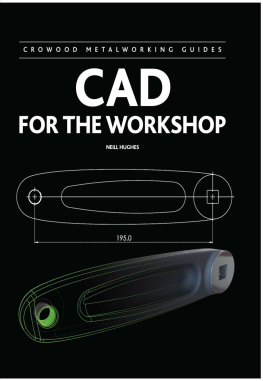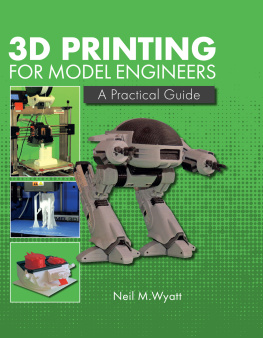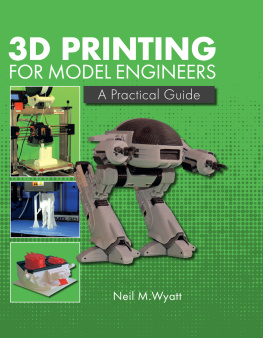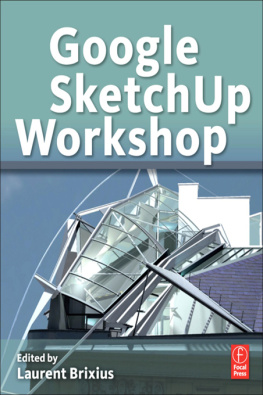CROWOOD METALWORKING GUIDES
CAD
FOR THE WORKSHOP
NEILL HUGHES

First published in 2013 by
The Crowood Press Ltd
Ramsbury, Marlborough
Wiltshire SN8 2HR
www.crowood.com
This e-book first published in 2013
Neill Hughes 2013
All rights reserved. No part of this publication may be reproduced or transmitted in any form or by any means, electronic or mechanical, including photocopy, recording, or any information storage and retrieval system, without permission in writing from the publishers.
British Library Cataloguing-in-Publication Data
A catalogue record for this book is available from the British Library.
ISBN 978 1 84797 567 6
Introduction
If you are interested in design and manufacturing and you have limited or no knowledge of what computer-aided design (CAD) technology can do for you, then you need to find out more about it and this book will help you do just that. It aims to clarify how CAD software can help you to record, visualize, design and make artefacts in the workshop. The artefacts could be anything from very precise, machined engineering components to steel welded or folded fabrications, complex mechanisms, or moulded product prototypes or freeform sculptures. Anything that you wish to make can benefit from being designed, documented and presented appropriately using CAD software.
There has never been a better time for any of us to have a fresh look at how we can use digital technology to support our creative, manufacturing or making activities in the workshop. There is a rich variety of design-related software now available, and mid-performance computing hardware can cost less than a television. It has become easier to use and is becoming more and more portable as the years go by. We can now do anything from drafting accurate 2D technical drawings to producing fully representational 3D virtual solid models of complex parts or fully mechanized assemblies, all on a personal computer of modest performance capabilities.
The focus of this book is on how to use CAD software in general to directly support making activities in the workshop, rather than how to operate machinery and tools or conduct the making activities themselves. It does not actually present step-by-step tutorials on how to operate CAD software, but provides guidance on general techniques, and software functionality and selection. The techniques described are not CAD software product specific, so they should hold true irrespective of the software product you use in the future. There are different types of CAD software of course, offering different functionality and different benefits. The distinctions between them are important to understand when selecting which software to use, and this, too, is discussed.
In order to set the scene, the first three chapters talk more generally about design and CAD, how a workshop is typically used, and the types of output files that CAD software uses, to produce for use in the workshop. clarifies established methods for product development with particular reference to specification, initial concepts, evaluation, embodiment design, detail design and manufacture. It also provides an overview of the functionality of CAD technology, and discusses the role of computer-aided techniques in the design and making process. The different types of CAD software available are also briefly analysed.
For readers with less practical workshop experience, some typical workshop tools and manufacturing processes are summarized in . Examples of their application, and typical limitations of achievable properties, such as accuracies and finishes, are provided. This knowledge often proves useful during initial design work and in annotating technical drawings.
The universal medium for accurately recording geometric information is, of course, the technical drawing. Most engineering design-based CAD software use will result in the production of a technical drawing for reference in the workshop during manufacture. presents an overview of the conventions, or language, of the technical drawing. This content provides a quick glance reference for working with technical drawing essentials, such as orthographic projection views, section views, line types, and dimension and tolerance annotation.
also discusses the computer-generated data requirements of automated machine tools and digital manufacturing processes, such as 3D printers and laser cutters. Todays digital manufacturing processes provide scope for the designer-maker to have complex components manufactured expeditiously, accurately and cost effectively. Processes such as laser cutting are particularly affordable and accessible to the private individual. If you can produce the source digital geometric data required you have more engagement with the process and more control of the quality of the output.
A range of case study examples are presented in the last chapter, illustrating the application of different CAD techniques for a range of workshop activity-related projects, all of which are destined to be made using specific manufacturing processes.
1 Computer-Aided Design and Manufacture
What aspects of design and workshop manufacturing can computer software help with? This chapter aims to answer this question by clarifying established methods for product or engineering design, discussing the role of computer-aided techniques in those methods, and providing an overview of CAD technology.
WHAT IS DESIGN?
The word design has a range of meanings, and the following sub-sections cite several definitions, each similar and complementary. Considering all of them may help you to develop your own understanding of what design means.
The dictionary definition:The Hugo English Pocket Dictionary defines design as a verb, meaning to plan out, intend, make, invent or pattern, and as a noun, meaning an intention, a plan, a purpose or a decorative pattern.
Bettina Von Stamms definition: Bettina Von Stamm, a recognized expert in the field of design and innovation management, presented three definitions of design in her book Managing Innovation, Design and Creativity:
Design is the tangible outcome that is, the end product such as cameras, cars, and so on
Design is a creative activity
Design is a process by which information is transformed into a tangible outcome
In her discussion of the definition of design Stamm emphasizes design as being a conscious decision-making process, and presents this explanation: Design is the conscious decision-making process by which information (an idea) is transformed into an outcome, be it tangible (a product) or intangible (a service).
The UK-SPEC definitions: In the UK, the definition and recognition of professional competencies in engineering is managed by the Engineering Council: they define what chartered engineers, incorporated engineers and engineering technicians should be able to do, and these definitions are summarized in a document called the UK-SPEC (United Kingdom Standard for Professional Engineering Competence). This document recognizes design as a specific skill, stating that:
Design is the creation and development of an economically viable product, process or system to meet a defined need.
Noel Carringtons definition: In his book The Shape of Things, published in 1939, Noel Carrington defines design as purpose + material + technique: what you are doing something for + what you will do it with + how you will do it.
Although a simple definition, it does summarize rather concisely the range of tasks or problems a designer is typically engaged with when he is designing, defining or specifying the requirements, and then creating solutions to meet those requirements.
Next page








![Tracy Fullerton [Tracy Fullerton] - Game Design Workshop, 3rd Edition](/uploads/posts/book/119440/thumbs/tracy-fullerton-tracy-fullerton-game-design.jpg)
